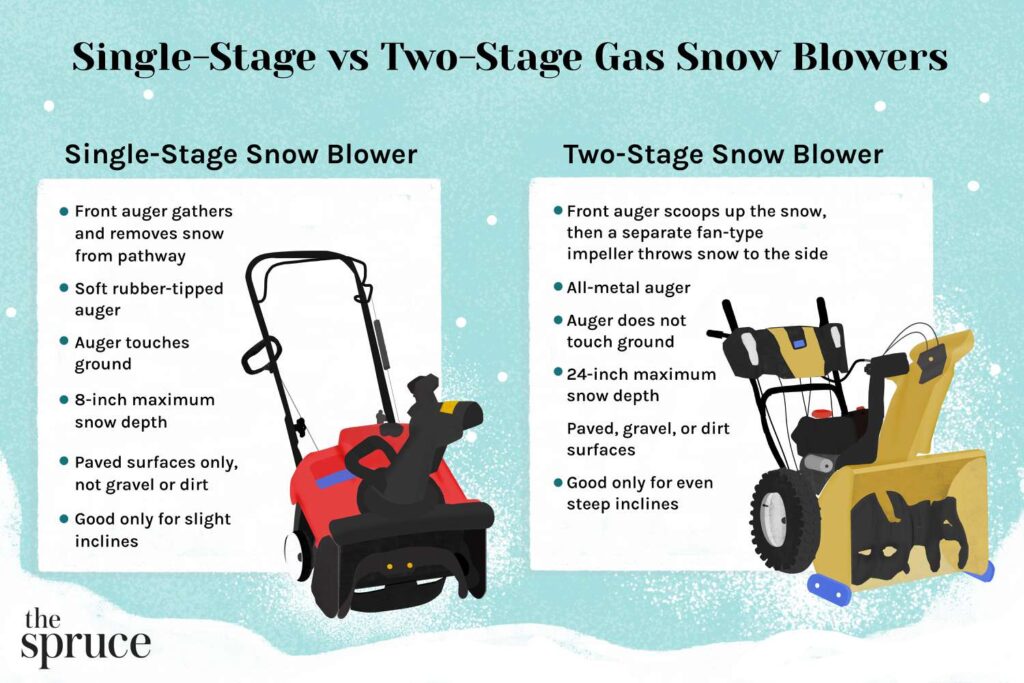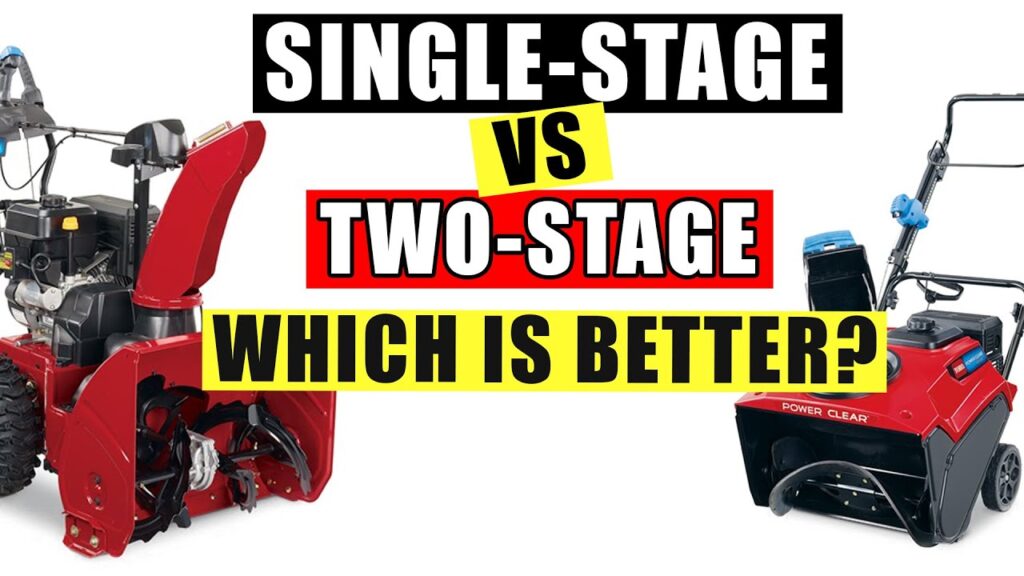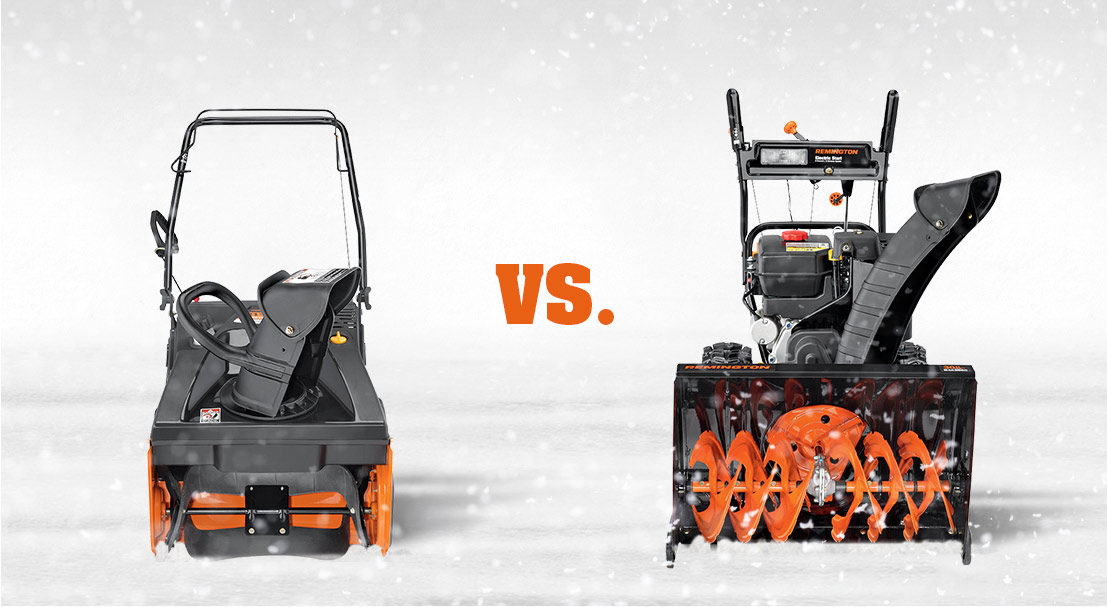Hello there! We’re here to chat about the age-old debate between two-stage and single-stage snow blowers. If you’ve been wondering which one is the better option for removing snow from your driveway or walkway, look no further! We’ll dive into the details and weigh the pros and cons of both types in our upcoming article.
Curious to learn more? In our article, we’ll explore the key differences between two-stage and single-stage snow blowers, and help you understand which one might be the best fit for your needs. Whether it’s the clearing width, throwing distance, or overall performance, we’ve got you covered. So stay tuned to uncover all the information you need to make an informed decision when it comes to battling snow this winter season.

This image is property of www.thespruce.com.
Understanding Two Stage Snow Blowers
Working Principle of Two Stage Snow Blowers
Two stage snow blowers are powerful machines designed to efficiently clear large amounts of snow. They operate using a two-step process. In the first stage, a metal auger scoops up the snow and feeds it into the machine. The auger breaks up the snow and ice, preparing it for the second stage. In the second stage, an impeller throws the snow out of the chute, effectively discharging it away from the cleared area.
Features and Advantages of Two Stage Snow Blowers
Two stage snow blowers offer several advantages over their single-stage counterparts. Firstly, they are capable of handling significantly higher amounts of snow. With their powerful engines and wide clearing widths, they can effortlessly handle heavy snowfall and clear large areas in a short amount of time. Additionally, two stage snow blowers are more efficient at handling wet and compacted snow, thanks to their auger and impeller combination.
One of the key features of two stage snow blowers is their ability to throw the snow over longer distances. This is especially useful when clearing driveways or larger areas, as it ensures the snow is not simply piled up in one spot, but rather thrown far away from the cleared path. This feature is particularly beneficial in regions with heavy snowfall, as it reduces the risk of snow buildup and allows for smoother snow removal.
Understanding Single-Stage Snow Blowers
Working Principle of Single-Stage Snow Blowers
Single-stage snow blowers operate on a different principle compared to their two stage counterparts. These machines are equipped with a high-speed auger that both scoops up the snow and propels it out of the chute in one step. As the auger comes into contact with the ground, it also helps to clear the snow right down to the surface.
Features and Advantages of Single-Stage Snow Blowers
Single-stage snow blowers are more compact and lightweight compared to two stage models, making them easier to maneuver and store. They are also generally more affordable, making them a popular choice for those with smaller budgets. Additionally, single-stage snow blowers are ideal for clearing snow on smaller surfaces, such as sidewalks, pathways, and decks.
Another advantage of single-stage snow blowers is their simplicity and ease of use. With fewer moving parts, maintenance and repairs are typically easier and less costly. These machines are also electrically powered, eliminating the need for gas and oil mixtures, resulting in cleaner and more environmentally-friendly operation.
Comparison: Two Stage vs Single-Stage Snow Blowers
Clearing Capacity and Efficiency
When it comes to clearing capacity and efficiency, two stage snow blowers have a clear advantage. With wider clearing widths and more powerful engines, they can handle larger snowfalls and clear larger areas more quickly. The two-stage process also allows for easier snow removal, especially when dealing with heavy and wet snow. Single-stage snow blowers, on the other hand, are better suited for lighter snowfall and smaller areas.
Handling Different Types of Snow
Two stage snow blowers have the upper hand when it comes to handling different types of snow. The combination of the auger and impeller allows them to efficiently break up and discharge wet and compacted snow. Single-stage snow blowers, while effective at handling lighter and fluffier snow, may struggle with heavier or icy snow.
Performance in Heavy Snowfall
In heavy snowfall conditions, two stage snow blowers outperform their single-stage counterparts. The wider clearing width and more powerful engines of two stage snow blowers enable them to clear larger amounts of snow more quickly. They are also less likely to become clogged or overwhelmed by the heavy snow, ensuring a smoother snow removal process.
Ease of Use and Maneuverability
Single-stage snow blowers generally have the advantage in terms of ease of use and maneuverability. Their lightweight and compact design make them easier to handle, especially in tight spaces or on uneven surfaces. Two stage snow blowers, while more powerful, may be more difficult to maneuver due to their larger size and weight.
Factors to Consider When Choosing a Snow Blower
Size of the Area to be Cleared
One important factor to consider when choosing between a two stage and a single-stage snow blower is the size of the area that needs to be cleared. If you have a large driveway or a large property with wide walkways, a two stage snow blower would be more suitable due to its wider clearing width and higher clearing capacity. For smaller areas, such as decks or narrow walkways, a single-stage snow blower may be sufficient.
Amount and Type of Snowfall
The amount and type of snowfall in your area should also be taken into consideration. If you frequently experience heavy and wet snow, a two stage snow blower would be better equipped to handle these conditions. On the other hand, if you typically have light and fluffy snow, a single-stage snow blower may be sufficient.
Budget and Affordability
Budget is another important factor when deciding between a two stage and a single-stage snow blower. Two stage models are generally more expensive due to their larger size and additional features. If you have a limited budget, a single-stage snow blower may be the more affordable option.
Storage Space Availability
Consider the amount of storage space you have available for your snow blower. Two stage snow blowers are larger and bulkier, requiring more storage space. If you have limited storage space, a single-stage snow blower may be a more practical choice.

This image is property of i.ytimg.com.
Pros and Cons of Two Stage Snow Blowers
Advantages of Two Stage Snow Blowers
- Higher clearing capacity and efficiency for larger areas
- Better at handling heavy and wet snow
- Ability to throw snow over longer distances
Disadvantages of Two Stage Snow Blowers
- Larger and bulkier, requiring more storage space
- More expensive compared to single-stage snow blowers
- Potentially more difficult to maneuver
Pros and Cons of Single-Stage Snow Blowers
Advantages of Single-Stage Snow Blowers
- Compact and lightweight, making them easy to maneuver and store
- More affordable compared to two-stage snow blowers
- Ideal for clearing smaller areas with lighter snowfall
Disadvantages of Single-Stage Snow Blowers
- Less efficient at handling heavy or wet snow
- Limited clearing capacity and efficiency for larger areas
- Electrically powered, may require access to electrical outlets or extension cords

This image is property of remingtonpowertools.com.
Factors That May Influence Your Decision
Cost
Consider your budget and the cost of both two stage and single-stage snow blowers. Evaluate whether the added features and advantages of a two stage snow blower are worth the higher price.
Snowfall Frequency and Volume
Take into account the typical snowfall frequency and volume in your area. If heavy snowfalls are common, a two stage snow blower may be a better investment to handle these conditions effectively.
Clearing Efficiency
Consider how quickly and efficiently you want to clear snow from your property. Two stage snow blowers have a higher clearing capacity and can clear larger areas more quickly compared to single-stage snow blowers.
Maneuverability and Ease of Use
Evaluate the ease of maneuverability and the level of physical strength required to operate the snow blower. Single-stage snow blowers are generally more lightweight and easier to handle, making them a better choice for those with physical limitations or smaller spaces.
Personal Preference and Individual Needs
Climate and Snow Conditions in Your Area
Consider the climate and snow conditions in your area. If you live in a region with heavy and wet snowfall, a two stage snow blower may be more suitable. If you experience lighter snowfall and have smaller areas to clear, a single-stage snow blower may be sufficient.
Physical Ability and Strength
Assess your own physical ability and strength. Two stage snow blowers are larger and heavier, requiring more strength to maneuver. If you have physical limitations or prefer a more lightweight option, a single-stage snow blower may be a better choice.
Desired Level of Comfort
Think about the level of comfort you prefer when operating a snow blower. Two stage snow blowers are more powerful and efficient, but may also be noisier and produce more vibrations. Single-stage snow blowers are generally quieter and may offer a smoother operation.

This image is property of www.simplicitymfg.com.
Conclusion
In conclusion, the choice between a two stage and a single-stage snow blower ultimately depends on your specific needs and preferences. Two stage snow blowers are better equipped to handle heavier snowfalls and larger areas, offering higher clearing capacity and efficiency. However, they are larger, more expensive, and may be more difficult to maneuver. On the other hand, single-stage snow blowers are more compact, affordable, and easier to use, making them a suitable choice for smaller areas and lighter snowfall. Consider the factors discussed in this article, weigh the pros and cons, and make an informed decision based on your unique circumstances.
